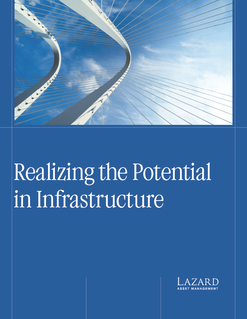Infrastructure is often associated with stability. But it can also offer characteristics that we believe are well-suited to the current macro environment, including potential inflation hedging, earnings resilience, and diversification. In our view, these benefits are best achieved with an active approach that combines valuation discipline with strict criteria for selecting companies.
For many investors, two years of higher inflation and central bank rate hikes may have seemed like an endurance test—replete with elevated market uncertainty and high volatility. This era of extremes is not a new development. It comes after more than two decades of macroeconomic and market extremes, from the bursting of the dot-com bubble and the Global Financial Crisis to the COVID-19 pandemic recession and recovery. Over much of that time, one asset class delivered resilient earnings growth and share price returns, albeit with some hiccups along the way: listed infrastructure.
In our view, during these volatile past two decades, listed infrastructure “grew up” as an asset class. It first emerged as a standalone offering in the early 2000s and has since grown into a full-fledged asset class in its own right at around 2% of global equity allocations, as Exhibit 1 shows.
EXHIBIT 1
The Growth of Listed Infrastructure
Source: eVestment
As of 31 December 2023
Too few investors focus on infrastructure in the asset allocation process, in our view. Instead, they tend to focus primarily on debt and equity and build other allocations around those two asset classes, in our view. The Lazard Global Listed Infrastructure portfolio seeks total return by investing in a select universe of “Preferred Infrastructure” companies that we believe can achieve lower-volatility returns that exceed inflation, presenting a potential diversification opportunity due to the mix of different infrastructure assets it contains. The portfolio may be a powerful complement to real assets, private equity infrastructure, and global equity allocations.
A Time for Infrastructure
Investors often come into the asset class seeking relative stability, along with the income and growth that equities have typically offered. Infrastructure assets, from airports and utilities to cellphone towers and satellites, are often associated with steadiness thanks to the streams of contract payments from customers, which translate into more predictable earnings.
Infrastructure can also offer characteristics that we believe are well suited to the current macro environment: potential inflation hedging, earnings resilience, and diversification.
Inflation and the Link to Cash Flows
Though inflation in most countries has receded from its peaks in 2021 and 2022, it remains above pre-pandemic levels. At the same time, the case for structurally higher goods inflation over the long term—supported by the reconfiguration of supply chains now underway and the energy transition, among other shifts—is compelling, in our view.
In an inflationary environment, infrastructure can play a key role in portfolios. This is because return targets are often set relative to inflation—our global listed strategy, for example, aims to generate 5% over the Consumer Price Index (CPI) over a market cycle—and we believe listed infrastructure assets can offer the best inflation protection properties available in public equity markets.
Because the degree of potential inflation protection varies significantly by company, selection is crucial. Based on our analysis, less than 25% of listed infrastructure companies can potentially offer true inflation protection. Within that 25%, the level of protection varies. Some have explicit (direct) inflation pass-through, while some have implicit inflation protection, depending on the terms of the underlying service contracts.
Exhibit 2 depicts the general inflation protection levels of listed infrastructure stocks by sector. UK, European, and Australian utilities, airports, and toll roads have historically had direct, explicit inflation pass-through: The contracts on these assets tied payments directly to the rate of inflation.
US utilities, railroads, and communication infrastructure returns, however, have historically been implicitly linked to inflation. US utilities’ earnings levels, for example, are typically set by regulators with a view to long-term interest rate assumptions, but these can move away from the CPI for periods of time until the regulators adjust the return levels. By contrast, US railway owners overall can set prices, and satellite companies typically establish fixed prices under long-term contracts.
EXHIBIT 2
Infrastructure’s Link to Inflation
As of 5 March 2024
RAB = Regulatory Asset Base
Source: Lazard
Looking at toll roads specifically, we believe they are a clear example of inflation protection built into the earnings. Toll road concessions are simple businesses: The owner of a concession, which has an average contract lasting between twenty and fifty years, charges tolls in exchange for building and maintaining the road. The formula to calculate the tolls has almost always been explicitly linked to the level of inflation (Exhibit 3).
EXHIBIT 3
CPI-Link Specification for Toll Roads
This information is for illustrative purposes only. The securities mentioned are not necessarily held by Lazard for all client portfolios, and their mention should not be considered a recommendation or solicitation to purchase or sell these securities. It should not be assumed that any investment in these securities was, or will prove to be, profitable.
Source: Lazard, Company Data
Earnings Resilience
As regulated monopolies providing essential services, Preferred Infrastructure assets—assets that we believe are best identified using a highly selective approach—typically enjoy highly inelastic demand profiles. Moreover, with very high operating profit margins and stable regulated returns, profits have been relatively protected from any given decline in revenues arising from economic stress. The earnings of utility companies or toll road operators have historically been more resilient than those of the average industrial stock in a recession: While consumers may cut discretionary spending in a downturn, for the most part, they typically still turn on the lights or travel by car. A stable earnings profile has also helped lead to a consistent yield premium for infrastructure over broader developed market equities (Exhibit 4).
EXHIBIT 4
Stable Earnings Can Lead to Consistent Yield Premium
As of 31 March 2024
Estimates based on historical financial accounts of companies held in the fully discretionary account. Statistics are calculated using an index style construction methodology. Investment characteristics are based upon a fully discretionary account. All estimates are based on current information and are subject to change. Past performance is not a reliable indicator of future results. This information is for illustrative purposes only. The performance quoted represents past performance. Past performance does not guarantee future results. The indices are unmanaged and have no fees. One cannot invest directly in an index.The Global Listed Infrastructure Index (AUD Hedged) from inception to 31 March 2015 is the UBS Global 50/50 Infrastructure and Utilities Net Index (AUD Hedged); from 1 April 2015 to 30 June 2018, the FTSE Developed Core Infrastructure 50/50 100% Hedged to AUD Net Tax Index; and thereafter, the MSCI World Core Infrastructure 100% Hedged to AUD Index.
Source: Lazard, FTSE, MSCI, UBS
Diversification Benefits and the Active Advantage
Based on MSCI index data from November 2005 through December 2023, listed infrastructure has occupied a position mid-way between equities and fixed income on the risk-return spectrum. Over time, it has had low return correlations to most other asset classes in addition to lower volatility than the broad equity markets. These attributes mean that infrastructure can potentially provide diversification within an investment portfolio overall, within an equity allocation, or alongside private equity in an infrastructure allocation. History shows that listed infrastructure has played an important role in portfolios in down markets, capturing only 57% of drawdown in negative months while capturing 77% of returns in positive months (Exhibit 5).
EXHIBIT 5
Upside-Downside Capture
As of 31 March 2024, since inception in September 2006.
All data in USD. The return-based characteristics are based on the gross-of-fees composite returns. Please refer to “GIPS® Composite Information” for additional information, including net-of-fee results. The performance quoted represents past performance. Past performance does not guarantee future results. No risk management technique or process can guarantee return or eliminate risk in any market environment. The index is unmanaged and has no fees. One cannot invest directly in an index.
Source: Lazard, MSCI
Looking at risk-return over the last 15 years, Exhibit 6 shows that while the MSCI World Infrastructure index has demonstrated lower risk compared with the global equities index (MSCI World), it has come at the expense of return relative to developed market equities. We believe listed infrastructure is an asset class where a selective approach from an active manager can add considerable value. The Lazard Global Listed Infrastructure strategy featured in the chart offered a more compelling risk/reward trade-off than the MSCI World Core Infrastructure Index.
EXHIBIT 6
Risk/Reward in Infrastructure
For the 15 years ending 31 March 2024
This information is for illustrative purposes only. The performance quoted represents past performance. Past performance is not a reliable indicator of future results. The indices listed above are unmanaged and have no fees. It is not possible to invest in an index. Inflation = CPI-U all items less food and energy, US city average, seasonally adjusted, 1982–84 = 100; US Bonds = Bloomberg US Aggregate Bond Index; Global Bonds = Bloomberg Global Aggregate Bond Index; US TIPS = Bloomberg US Government Inflation-Linked Bond Index; Infrastructure = MSCI ACWI Core Infrastructure Index Net Return; Commodities = S&P GSCI TR; US REITs = FTSE NAREIT All Equity REITs Index TR; Developed Market Equities = MSCI World Index Gross Return; Emerging Markets Equities = MSCI Emerging Markets Index Gross Return. Lazard Global Listed Infrastructure = Lazard Global Listed Infrastructure (USD Hedge) Composite
Source: Lazard, Standard & Poor’s, MSCI, Bloomberg, NAREIT, UBS, FactSet
Seeking Stable Returns and Income
Railways, roads, airports, and utilities form the backbone of modern society. Thanks to their reliable earnings history, many investors have turned to listed infrastructure securities in search of stable returns and income.
We believe listed infrastructure can potentially provide a contractual inflation linkage in cash flows, stable returns through economic cycles, a low risk of capital loss, ‘rising coupons’ through real earnings growth, and, finally, diversification benefits via low volatility and low correlations to other asset classes. In our view, the benefits of the asset class are best achieved by taking an active, selective approach—one that combines valuation discipline with strict criteria for selecting companies.
Download PDF



